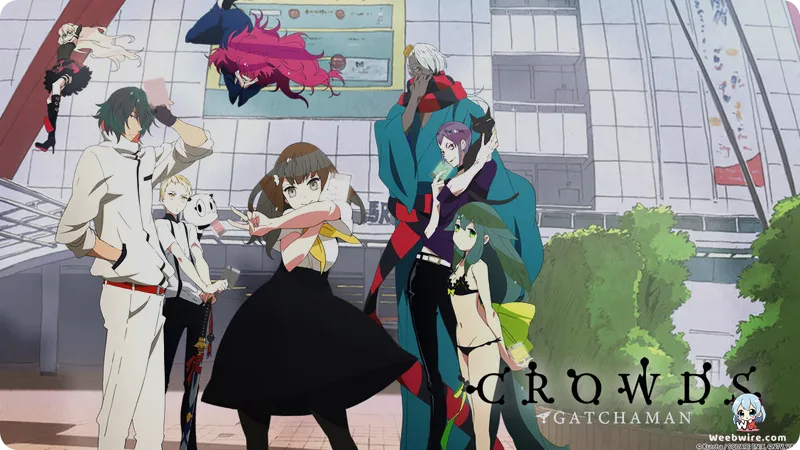Gatchaman Crowds: A Visionary Deconstruction of Heroism and Society in the Digital Age

Prepare to delve into the groundbreaking world of Gatchaman Crowds, a 2013 anime series that boldly redefined the classic Gatchaman franchise. Originally birthed by Tatsunoko Production in the 1970s, this iteration stands far from a simple revival. It is a profound deconstruction of heroism, collective action, and the intricate complexities of the digital age, brimming with narrative ingenuity and thought-provoking themes that continue to captivate audiences worldwide.
Hajime Ichinose: An Unconventional Hero
At its heart lies the captivating protagonist, Hajime Ichinose, a character who shatters conventional heroic molds. Unlike the stoic or brooding figures often seen in action anime, Hajime is a vibrant force of boundless optimism, characterized by her quirky observations and an almost disarming innocence. Her iconic phrase, "Let's get excited!" perfectly encapsulates her approach to even the most daunting scenarios. This isn't just a charming quirk; it's a cornerstone of the show's philosophical stance.
Hajime consistently subverts traditional heroic narratives, favoring dialogue and understanding over brute force. She even forges unexpected connections with antagonists, discovering common ground where others perceive only conflict. Her unique perspective compels viewers to re-evaluate the very essence of heroism, establishing her as arguably the most refreshing Gatchaman ever to grace the screen. This deliberate departure from the norm was a visionary choice by director Kenji Nakamura, acclaimed for his intellectually stimulating works such as Mononoke and [C] The Money of Soul and Possibility Control, who sought to explore modern societal intricacies through the lens of an established superhero narrative.
The Prescient CROWDS System
Central to the series' innovation is the titular "CROWDS" system. More than a mere plot device, the CROWDS represent a potent manifestation of collective human will, enabling individuals to project their thoughts and emotions into tangible, often amorphous, forms. This system, conceived by the genius Rui Ninomiya, was designed to facilitate global problem-solving via a real-time social network named GALAX. This concept proved remarkably prescient, anticipating the rise of social media activism and the dual nature of collective anonymity long before they became widespread societal discussions. The series masterfully explores how this immense power can be wielded for both profound good and destructive chaos, expertly blurring the lines between hero and villain, individual responsibility and collective action.
Berg Katze: A Unique Antagonist
Adding another layer of depth is the primary antagonist, Berg Katze, who defies the typical world-domination archetype. Instead, Katze is an alien entity of pure chaos, driven by an insatiable desire to ignite conflict and revel in human negativity. Katze seeks neither conquest nor power; rather, this entity thrives on manipulation, frequently adopting the forms and voices of others to sow discord and exploit societal vulnerabilities for sheer amusement. This abstract and almost existential threat compels the Gatchaman team to confront not merely a physical adversary, but the very essence of human darkness and the intrinsic seeds of conflict within society itself. Katze's unpredictable nature and unsettling delight in destruction forge a truly unique and psychologically resonant antagonist.
The Gatchaman Suits and Visuals
The Gatchaman suits themselves conceal a unique secret. They are not simply advanced armor; they are physical manifestations of the user's "NOTE," a special power inherited from an alien entity. Each Gatchaman's suit is distinctively designed, reflecting their individual personality and abilities, and is powered by the user's life force. This profound personal connection to their powers further underscores the show's overarching theme of individuality and the intrinsic strength residing within each person, rather than relying solely on external technology.

Visually, Gatchaman Crowds is a spectacular feast for the eyes. Kenji Nakamura's signature style, characterized by vibrant color palettes, abstract visual metaphors, and dynamic animation, imbues the series with a truly distinctive aesthetic. The CROWDS manifestations, in particular, are depicted with a dazzling array of colors and fluid shapes, transforming battles into psychedelic ballets of light and shadow. The energetic opening theme "Crowds" by WHITE ASH, alongside various compelling insert songs, perfectly complements the show's often frenetic pace and introspective moments, significantly enhancing its unique atmosphere.
Themes and Legacy
The series fearlessly delves into complex themes such as the nature of anonymity in online spaces, the profound responsibility that accompanies power, and the inherent difficulty of defining "justice" in a morally ambiguous world. It challenges viewers to question their own preconceived notions of good and evil, urging them to look beyond simplistic black-and-white morality. The subsequent season, Gatchaman Crowds insight, further expanded upon these ideas, exploring the dangers of populism and mob mentality, and the delicate balance between collective good and oppressive uniformity.
Ultimately, Gatchaman Crowds stands as a powerful testament to creative courage and intellectual ambition. It is a series that dares to reinvent a beloved classic not merely for the sake of novelty, but to offer a profound, often uncomfortable, reflection on contemporary society. Its unconventional hero, unique villains, and deeply philosophical themes make it an essential watch for anyone interested in anime that pushes boundaries and sparks genuine thought, cementing its place as a truly good-to-know gem in the landscape of modern animation.
Credits
Gatchaman Crowds
Author
Tatsunoko Production
Cover Art
Yuichi Takahashi
Studio
Tatsunoko Production
Publisher
VAP
Producers





